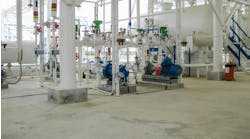The chemical industry today is focusing more and more on water. Manufacturers are decreasing their volume of water intake and increasing recycling and reclamation. (See: “Chemical Processing Plants Save Water.")
In some cases, selection of different pumping technology can help reduce water consumption dramatically and, in so doing, cut costs associated with water conditioning for process use, reconditioning for further service or disposal. Pumping of slurries represents one such opportunity.
Figure 1. Pump has two arms with fixed shoes (left) or rollers (right), so hose is compressed twice each revolution.
Figure 2. Because of the eccentric rotation of the roller, hose only is compressed once each revolution.
ALTERNATIVESProcessors can consider several pumping technologies for slurries. For instance, progressive cavity pumps might be a good choice for lighter slurries. However, they require homogeneous solids and can’t accept as wide a range of particle sizes as peristaltic pumps. On the other hand, progressive cavity and other types of pumps can handle much higher flow rates than peristaltic pumps, which have a maximum continuous pumping capacity of approximately 440 gal/min.Air-operated diaphragm pumps also can handle slurries and are inexpensive to purchase. However, slurries pose some challenges for them. Fouling of the ball checks may be a problem. Also, depending upon the chemical, these pumps may experience vacuum degassing. Moreover, air is a much more costly utility than electricity, making the pumps expensive to operate.Peristaltic pumps are gaining popularity because of their ability to pump highly concentrated slurries, including very abrasive or extremely corrosive ones. In a peristaltic pump, only a single hose contacts the slurry. That hose typically is the only wearing part in the pump, making the pump both simpler to repair and much less costly to maintain than a centrifugal pump. A variety of hose materials are available; by just changing the hose, a plant can process a completely different slurry. Very few pumping technologies offer this flexibility. Moreover, a peristaltic pump has excellent control characteristics. Simply by speeding the pump up or slowing it down, you can control a process very accurately. The hose puts out an exact volume per revolution; you don’t have to contend with pump curves with a peristaltic pump. Another unique advantage is that the pump acts as its own shut-off device. Many other types of pumps may allow continuous flow through when the pump is turned off. The Achilles heel of certain types of peristaltic pumps has been relatively short hose life. Peristaltic pumps have existed for more than 80 years. Rubber technology has advanced drastically in those years. However, until recently, the design principle of peristaltic pumps remained unchanged. Most designs have a fixed rotation point in the center hub of the peristaltic pump. Two arms protrude from that point to the hose; the end of each arm has either a shoe (Figure 1a) or a roller (Figure 1b) to compress the hose. So, the rubber hose gets compressed twice every full revolution. The number one factor in determining the life of the hose is how many times it’s compressed. Today, peristaltic pumps that use a cam and a roller offset from the center rotation point are available. The eccentric rotation of the single roller compresses the rubber hose once every revolution. This results in hose life that’s often three-to-five times longer than that of conventional designs.Besides halving the number of compressions, the design also eliminates the friction incurred in other designs. Fixed shoes create significant friction when the shoes ride over and compress the rubber hose. To dissipate the heat generated by this friction, a large amount of glycerin is put in the pump housing. Nevertheless, the heat still takes a toll and contributes to the relatively short hose life of shoe-design peristaltic pumps. In contrast, a cam-shaft-offset-roller pump uses a small amount of glycerin for light lubrication. A 2.5-in. shoe-design pump will need approximately 5 gallons of glycerin while a cam-shaft-offset-roller 2.5-in. pump only will use about ½ gallon.In addition, particularly in larger diameter pumps, a cam-shaft-offset-roller design might require a smaller motor size, reducing energy consumption. Overall, the pump’s operating costs run approximately 60% less than those of a double-shoe or double-roller design. RETHINK SLURRY PUMPINGA peristaltic pump can provide a good option for saving water when handling a slurry. Because the hose is the only component contacting the medium, such a pump offers advantages for dealing with abrasive and corrosive media, and sometimes can obviate the use of exotic alloys. The newer designs of peristaltic pumps have helped improve reliability and reduce operating costs, thus making the pumps attractive choices for pumping slurries with high solids content.
TODD LOUDIN is president/CEO of Flowrox, Linthicum, Md. E-mail him at [email protected].




